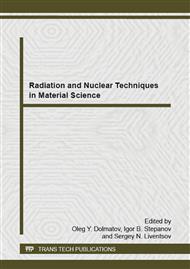[1]
M. Daunys, R. Dundulis, A. Grybenas, P. Krasauskas, Hydrogen influence on mechanical and fracture mechanics characteristics of zirconium Zr–2. 5Nb alloy at ambient and elevated temperatures, Nucl. Eng. and Design. 238 (2008) 2536-2545.
DOI: 10.1016/j.nucengdes.2008.05.018
Google Scholar
[2]
D. Olander, E. Greenspan, H.D. Garkisch, B. Petrovic, Uranium–zirconium hydride fuel properties, Nucl. Eng. and Design. 239 (2009) 1406–1424.
DOI: 10.1016/j.nucengdes.2009.04.001
Google Scholar
[3]
A. Zielinski, S. Sobieszczyk, Hydrogen-enhanced degradation and oxide effects in zirconium alloys for nuclear applications, Int. J. of Hyd. En. 36 (2011) 8619–8629.
DOI: 10.1016/j.ijhydene.2011.04.002
Google Scholar
[4]
C. Domain, R. Besson, A. Legris, Atomic-scale Ab-initio study of the Zr-H system: I. Bulk properties, ActaMat. 50 (2002) 3513-3526.
DOI: 10.1016/s1359-6454(02)00173-8
Google Scholar
[5]
J.J. Kearns, Diffusion coefficient of hydrogen in alpha zirconium, Zircaloy-2 and Zircaloy-4, J. of Nucl. Mat. 43 (1972) 330-338.
DOI: 10.1016/0022-3115(72)90065-7
Google Scholar
[6]
C. -S. Zhang, B. Li, P.R. Norton, The study of hydrogen segregation on Zr(0001) and Zr(100) surfaces by static secondary ion mass spectroscopy, work function, Auger electron spectroscopy and nuclear reaction analysis, Journal of Alloys and Compounds. 231 (1995).
DOI: 10.1016/0925-8388(95)01847-6
Google Scholar
[7]
Y. Fukai, The metal-hydrogen system, Springer-Verlag, Heidelberg, (1993).
Google Scholar
[8]
R.O. Jones, O. Gunnarsson, The density functional formalism, its applications and prospects, Rev. Mod. Phys. 61 (1989) 689-746.
DOI: 10.1103/revmodphys.61.689
Google Scholar
[9]
S. Blügel, G. Bihlmayer, Full-Potential Linearized Augmented Planewave Method, Comput. Nanosci. 31 (2006) 85-129.
Google Scholar
[10]
Information on http: /www. flapw. de.
Google Scholar
[11]
J.P. Perdew, K. Burke, E. Matthias, Generalized Gradient Approximation Made Simple, Phys. Rev. Let. 77 (1996) 3865-3868.
DOI: 10.1103/physrevlett.77.3865
Google Scholar
[12]
J. Garcés, R. González, P. Vajda, First-principles study of H ordering in the α phase of M-H systems (M=Sc, Y, Ti, Zr), Phys. Rev. B. 79 (2009) 054113.
Google Scholar
[13]
F. Wang, H.R. Gong, First principles study of various Zr-H phases with low H concentrations, International Journal of Hydrogen Energy. 37 (2012) 12393-12401.
DOI: 10.1016/j.ijhydene.2012.06.037
Google Scholar


